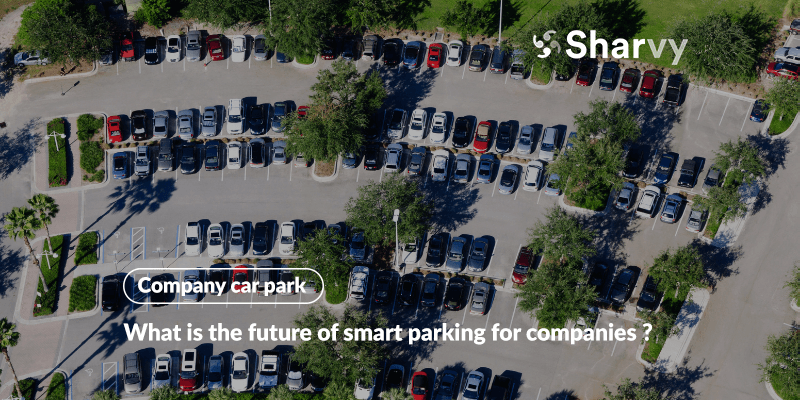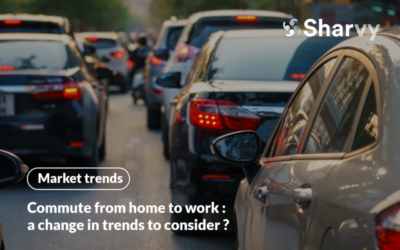There’s no doubt about it : parking is now at the heart of the debate on mobility in the city.
As the backbone of urban life, it is at the crossroads of several issues : the environment, the economy and people’s quality of life. It is a source of congestion and pollution, but also a brake on the vitality of city centres.
This is why the place of the car in the urban environment is increasingly being called into question. And in light of this, intelligent parking is emerging as an innovative and necessary response.
However, businesses must be the first to act. The reason is obvious: a large proportion of traffic jams occur during weekday rush hours, when thousands of employees are on their way to work.
By rethinking their practices, businesses have the power to make a real difference to urban mobility – and give real meaning to the promise of intelligent parking.
In this article, find out how intelligent parking is emerging as the solution of the future for transforming urban mobility, and why it’s crucial for businesses to take the lead in this revolution!
What is smart parking for companies?
Smart parking for companies relies on the use of advanced technologies, such as IoT sensors, mobile applications & real-time data collection systems to improve the use of parking spaces, and simplify the user experience.
As a result, it is reinventing the way we use & manage corporate car parks, moving from a static & manual model to connected management.
Note that the term « smart parking » encompasses 3 levels of innovation :
- Technological innovation : with the integration of various technologies, such as IoT sensors & real-time data collection systems. By aggregating this data in real time, Artificial Intelligence (IA) algorithms can be used to carry out predictive analyses of peak periods and thus anticipate parking demand.
- Digitalising the user experience : using parking management applications such as Sharvy makes it easier to manage parking in the workplace. Employees can reserve a parking space in advance, reducing the search for a space and congestion around car parks. Access control is also made easier thanks to technologies such as automatic number plate recognition, making entry more fluid and reducing queues. What’s more, if an employee with a reserved space is absent, the application automatically reallocates the space to another user, maximising the use of available spaces.
- Improving the parking experience : by offering a series of practical & personalised improvements throughout the driver’s journey. Thanks to applications such as Sharvy, users receive real-time notifications when a space becomes available, even if they are still en route. In the event of an incident in the car park (such as a charging point breaking down), alerts are also sent. Some solutions can also manage the recharging of electric vehicles, for a smooth, stress-free experience.
In this way, the car park becomes an agile, responsive and, above all, intelligent space.
The trends that are shaping the future of smart parking for companies.
1. IoT sensors in every parking space.
Although small & medium-sized enterprises (SMEs) can also benefit, these technologies are (more often) found in large companies with extensive & complex car parks.
And it’s easy to see why: these IoT sensors provide real-time information on the exact occupancy of each parking space, giving employees and managers alike a clear overview.
It should be noted, however, that there are several types of IoT sensor – magnetic wave, infrared and ultrasonic – which are chosen according to the characteristics of the site: covered car park, outdoor car park, asphalt or concrete surface, etc. This adaptation ensures reliable detection whatever the type of site. This adaptation guarantees reliable detection whatever the conditions.
What’s more, they’re easy to install (simply screwed into the ground, or even buried), and require no major work or advanced technical skills. Their autonomy and robustness reduce maintenance requirements to a minimum, making them a reliable and durable solution for businesses.
However, their real strength lies in their ability to transform the user experience. By instantly transmitting occupancy data on display panels, or via a dedicated application, they can direct drivers directly to available spaces.
The result: less time wasted driving in circles, less stress, less pollution, and a much smoother flow of traffic. And for car park managers, it’s a powerful real-time management and optimisation tool.
2. Mobile applications to make it easier to book & allocate a space.
At a time when city centres are suffocating under the pressure of traffic, particularly at peak times, applications like Sharvy are radically transforming parking management.
By enabling employees to reserve a space in advance, or to obtain one as soon as it becomes available, they eliminate unnecessary circling around car parks – the main culprits of urban congestion (up to 30% of urban traffic in certain areas, according to a study by CEREMA, in 2024).
Better still, these applications are often connected to the company’s HRIS software, enabling them to automatically cross-reference data on absences, holidays and teleworking. Unoccupied spaces are reallocated in real time to those who need them, without any loss of space.
It is precisely this ability to adapt dynamically to usage, work patterns and urban constraints that makes these tools the future of intelligent parking.
3. Number plate recognition cameras (ANPR system).
Number plate recognition cameras are gradually replacing traditional car park access systems such as RFID badges.
RFID badges (which are still widely used) have a number of limitations: they can be forgotten, lost or shared between colleagues. These are all obstacles to smooth, secure parking management.
In contrast, ANPR cameras offer totally automated, contactless and frictionless access management. Thanks to this technology, vehicles are identified in real time as soon as they arrive, so there are no delays at car park entrances and no queues at peak times.
This saves time for employees and gives managers better control over traffic flow, particularly in dense areas around city centres.
But plate recognition doesn’t just improve traffic flow: it also enhances security and simplifies access administration, with a direct link to the company’s internal databases.
By combining ease of use and automation, this technology is set to become a standard of smart parking for companies – and a key asset.
4. AI & scenario prediction to enhance the employee experience.
Artificial intelligence (AI) is one of the driving forces behind tomorrow’s intelligent parking.
Like Waze, which suggests a driver’s usual route if they take the same journey every day, AI applied to intelligent parking can also adjust access to car parks in real time. It takes into account drivers’ habits & traffic conditions.
For example, if an employee books a parking space via an application (such as Sharvy), the AI can predict his arrival time based on his habits & trigger the automatic opening of the barrier at that precise moment.
It can also take account of traffic jams and conditions to facilitate vehicle entry, even during periods of congestion. This avoids queues and ensures a smooth flow of vehicles, both inside and outside the car park.
What’s more, this ability to anticipate needs based on actual circumstances means that employees gain in efficiency and comfort.
5. An integrated vision for global, dynamic parking management.
Intelligent parking is not limited to optimising parking spaces, but aims for a complete overhaul of the parking system within companies.
The aim is twofold: to improve the use of car parking spaces, but also to improve the range of parking options available (bicycles, charging points for electric vehicles, motorbikes and scooters, etc.).
In this model, a dedicated application (such as Sharvy) centralises the management of all these parking options, giving users real-time visibility of the availability of spaces, whatever their mode of transport.
This complete visibility of the company car park makes the adoption of new modes of transport more attractive.
If an employee notices the day before that there are no parking spaces available for the next day, he or she can turn more easily to environmentally-friendly alternatives, such as cycling and scootering, without fearing that there will be no parking available for these modes of transport.
This encourages employees to switch more naturally to an alternative mode of transport when the need arises, knowing that parking for these options is always available and well integrated into the overall system.
Challenges to overcome in the global deployment of smart parking for companies.
1.Data security and confidentiality: a critical issue for businesses.
Smart parking systems rely on connected technologies, such as IoT sensors, mobile applications & the cloud.
This connectivity raises the issue of protecting users’ personal data (location, timetables, vehicle registration, etc.).
To guarantee their trust, companies need to implement robust cybersecurity protocols and comply with regulations such as the RGPD. The slightest flaw could compromise not only the data, but also the company’s image.
2. Implementation and maintenance costs of smart parking for many companies.
Deploying an intelligent parking system does, however, require significant investment on the part of companies : both for installing the infrastructure (sensors, terminals, software & applications) and for maintaining it.
For managers of company sites, these costs can be an obstacle, particularly in the absence of subsidies or clearly identifiable short-term returns on investment.
3. User support for smart parking : a key success factor.
The success of a smart parking system depends above all on its adoption by users. However, some employees may be wary, fearing technology that is perceived as too complex and intrusive.
To overcome these obstacles, it is crucial to change management through awareness-raising campaigns and user-friendly interfaces such as Sharvy, and to back up these arguments with concrete benefits (time savings, comfort, reliability). The more fluid the user experience, the more natural adoption will be.
In conclusion
Faced with saturated urban environments, chronic traffic jams and environmental imperatives, intelligent parking is emerging as a solution for the future.
In the future, companies will no longer be satisfied with simply car park management, they will be piloting a genuine mobility ecosystem, capable of adapting to traffic flows, habits and urban constraints.
Intelligent parking will no longer be an ancillary service, but a strategic lever for improving the quality of life at work, supporting the ecological transition and relieving congestion in cities.
Do you have a question? Check out the following FAQ !
Is smart parking only for large companies?
No, intelligent parking is not just for large companies.
Although large groups have often been the first to adopt these solutions (because of their more complex infrastructures), many solutions today are flexible, & adapted to SMEs, like the Sharvy solution.
Even with a small number of spaces, a company can benefit from optimised management, intelligent sharing of spaces between employees, and reductions in parking-related tensions.
What’s more, these tools enable SMEs to enhance their CSR commitment, improve the quality of life at work & stand out from the crowd in an increasingly competitive labour market!
What are the main differences between smart parking parking solutions & traditional methods?
Unlike traditional methods that rely on manual, inflexible systems (paper tickets & RFID badges), intelligent parking uses technologies such as IoT sensors, plate recognition cameras and mobile applications to collect & analyse data in real time.
The result is optimised management of available spaces, automatic reallocation of spaces and reduced queuing thanks to automated access control.
Applications such as Sharvy offer a range of functionalities, including advance seat reservations and real-time notifications, making the experience more fluid and personalised. In comparison, traditional methods are often rigid, less responsive & don’t allow for such dynamic management or optimal use of parking spaces.
Want to find out more? Check out our latest articles to stay up to date!
How can your inter-company restaurant adapt to teleworking?
Teleworking : how can you manage the number of people using your inter-company restaurant & adapt your offer to new working habits? Focus.
Change management : how to facilitate the adoption of a new tool?
What are the essential steps to facilitate change management in your company ? Our advice and best practices can be found here.
Commute from home to work : a change in trends to consider ?
Commute from home to work : what trends can be observed? What are the risks? How can they be improved? Focus in this article.
Subscribe to our newsletter!
PARKING & WORKPLACE MANAGEMENT SOLUTION
Car park management - Charging points monitoring - Desk booking - Booking by time slots
SUBSCRIBE TO THE NEWSLETTER
Receive the latest Parking & Workplace trends by email once a month.













